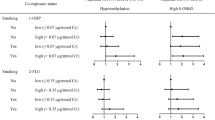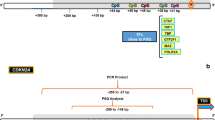Abstract
Recently, diesel engine exhaust (DEE) was reclassified as a known carcinogen to humans. DNA methylation alterations in DNA damage response (DDR)-related genes have the potential to affect DEE exposure-related cancer risk. However, the evidence regarding the association between DEE exposure and methylation alterations in DDR-related genes is limited. In 117 DEE-exposed workers and 112 non-DEE-exposed workers, we measured urinary concentrations of six mono-hydroxylated polycyclic aromatic hydrocarbons (OH-PAHs). We also determined the methylation levels of three DDR-related genes (p16, RASSF1A, and MGMT) and LINE-1 by bisulfite-pyrosequencing assay. We found that DEE-exposed workers exhibited significantly lower mean promoter methylation levels of p16, RASSF1A, and MGMT than non-DEE-exposed workers (all p < 0.001). In all study subjects and non-smoking workers, increasing quartiles of urinary summed OH-PAHs was associated with hypomethylation of p16, RASSF1A, and MGMT (all p < 0.05). In non-smoking workers, methylation in p16, RASSF1A, and MGMT decreased by 0.36 % [95 % confidential interval (CI): −0.60, −0.11 %], 0.46 % (95 % CI: −0.79, −0.14 %), and 0.55 % (95 % CI: −0.95, −0.15 %), respectively, in association with highest versus lowest quartile of urinary summed OH-PAHs. In addition, p16, RASSF1A, MGMT, and LINE-1 methylation levels showed negative correlations with cytokinesis-block micronucleus cytome index which was previously measured in the same workers (all p < 0.05). In conclusion, our results clearly indicated that DEE exposure and increased genetic damage were associated with hypomethylation of p16, RASSF1A, and MGMT. Future studies with larger sample size are needed to confirm these associations.

Similar content being viewed by others
References
Bartkova J, Horejsi Z, Koed K, Kramer A, Tort F, Zieger K et al (2005) DNA damage response as a candidate anti-cancer barrier in early human tumorigenesis. Nature 434:864–870
Benbrahim-Tallaa L, Baan RA, Grosse Y, Lauby-Secretan B, El Ghissassi F, Bouvard V et al (2012) Carcinogenicity of diesel-engine and gasoline-engine exhausts and some nitroarenes. Lancet Oncol 13:663–664
Berwick M, Vineis P (2000) Markers of DNA repair and susceptibility to cancer in humans: an epidemiologic review. J Natl Cancer Inst 92:874–897
Bonassi S, Znaor A, Ceppi M, Lando C, Chang WP, Holland N et al (2007) An increased micronucleus frequency in peripheral blood lymphocytes predicts the risk of cancer in humans. Carcinogenesis 28:625–631
Daskalos A, Nikolaidis G, Xinarianos G, Sawari P, Cassidy A, Zakopoulou R et al (2009) Hypomethylation of retrotransposable elements correlates with genomic instability in non-small cell lung cancer. Int J Cancer 124:81–87
Dolinoy DC, Weidman JR, Jirtle RL (2007) Epigenetic gene regulation: linking early developmental environment to adult disease. Reprod Toxicol 23:297–307
Duan H, He Z, Ma J, Zhang B, Sheng Z, Bin P et al (2013) Global and MGMT promoter hypomethylation independently associated with genomic instability of lymphocytes in subjects exposed to high-dose polycyclic aromatic hydrocarbon. Arch Toxicol 87:2013–2022
El-Zein RA, Schabath MB, Etzel CJ, Lopez MS, Franklin JD, Spitz MR (2006) Cytokinesis-blocked micronucleus assay as a novel biomarker for lung cancer risk. Cancer Res 66:6449–6456
El-Zein RA, Fenech M, Lopez MS, Spitz MR, Etzel CJ (2008) Cytokinesis-blocked micronucleus cytome assay biomarkers identify lung cancer cases amongst smokers. Cancer Epidemiol Biomark Prev 17:1111–1119
Fenech M (2006) Cytokinesis-block micronucleus assay evolves into a “cytome” assay of chromosomal instability, mitotic dysfunction and cell death. Mutat Res 600:58–66
Fenech M (2012) Folate (vitamin B9) and vitamin B12 and their function in the maintenance of nuclear and mitochondrial genome integrity. Mutat Res 733:21–33
Fratelli M, Goodwin LO, Orom UA, Lombardi S, Tonelli R, Mengozzi M et al (2005) Gene expression profiling reveals a signaling role of glutathione in redox regulation. Proc Natl Acad Sci USA 102:13998–14003
Fujiwara K, Fujimoto N, Tabata M, Nishii K, Matsuo K, Hotta K et al (2005) Identification of epigenetic aberrant promoter methylation in serum DNA is useful for early detection of lung cancer. Clin Cancer Res 11:1219–1225
Hou L, Zhang X, Tarantini L, Nordio F, Bonzini M, Angelici L et al (2011) Ambient PM exposure and DNA methylation in tumor suppressor genes: a cross-sectional study. Part Fibre Toxicol 8:25
Hsu HS, Chen TP, Hung CH, Wen CK, Lin RK, Lee HC et al (2007) Characterization of a multiple epigenetic marker panel for lung cancer detection and risk assessment in plasma. Cancer 110:2019–2026
IARC (1989) IARC monographs on the evaluation of carcinogenic risks to humans. Diesel and gasoline engine exhausts and some nitroarenes. International Agency for Research on Cancer. IARC Monogr Eval Carcinog Risks Hum 46:1–458
Jackson SP, Bartek J (2009) The DNA-damage response in human biology and disease. Nature 461:1071–1078
Jiang R, Jones MJ, Sava F, Kobor MS, Carlsten C (2014) Short-term diesel exhaust inhalation in a controlled human crossover study is associated with changes in DNA methylation of circulating mononuclear cells in asthmatics. Part Fibre Toxicol 11:71
Kaina B, Christmann M, Naumann S, Roos WP (2007) MGMT: key node in the battle against genotoxicity, carcinogenicity and apoptosis induced by alkylating agents. DNA Repair (Amst) 6:1079–1099
Klumper C, Kramer U, Lehmann I, von Berq A, Berdel D, Herberth G et al (2015) Air pollution and cytokine responsiveness in asthmatic and non-asthmatic children. Environ Res 138:381–390
Liggett WH Jr, Sidransky D (1998) Role of the p16 tumor suppressor gene in cancer. J Clin Oncol 16:1197–1206
Olsson AC, Gustavsson P, Kromhout H, Peters S, Vermeulen R, Bruske L et al (2011) Exposure to diesel motor exhaust and lung cancer risk in a pooled analysis from case-control studies in Europe and Canada. Am J Respir Crit Care Med 183:941–948
Pikor L, Thu K, Vucic E, Lam W (2013) The detection and implication of genome instability in cancer. Cancer Metastasis Rev 32:341–352
Puett RC, Hart JE, Yanosky JD, Spiegelman D, Wang M, Fisher JA et al (2014) Particulate matter air pollution exposure, distance to road, and incident lung cancer in the nurses’ health study cohort. Environ Health Perspect 122:926–932
Raaschou-Nielsen O, Andersen ZJ, Beelen R, Samoli E, Stafoggia M, Weinmayr G et al (2013) Air pollution and lung cancer incidence in 17 European cohorts: prospective analyses from the European study of cohorts for air pollution effects (ESCAPE). Lancet Oncol 14:813–822
Reinius LE, Acevedo N, Joerink M, Pershagen G, Dahlen SE, Greco D et al (2012) Differential DNA methylation in purified human blood cells: implications for cell lineage and studies on disease susceptibility. PLoS ONE 7:e41361
Rouse J, Jackson SP (2002) Interfaces between the detection, signaling, and repair of DNA damage. Science 297:547–551
Shin DY, Sung Kang H, Kim GY, Kim WJ, Yoo YH, Choi YH (2013) Decitabine, a DNA methyltransferases inhibitor, induces cell cycle arrest at G2/M phase through p53-independent pathway in human cancer cells. Biomed Pharmacother 67:305–311
Shivakumar L, Minna J, Sakamaki T, Pestell R, White MA (2002) The RASSF1A tumor suppressor blocks cell cycle progression and inhibits cyclin D1 accumulation. Mol Cell Biol 22:4309–4318
Vermeulen R, Silverman DT, Garshick E, Vlaanderen J, Portengen L, Steenland K (2014) Exposure-response estimates for diesel engine exhaust and lung cancer mortality based on data from three occupational cohorts. Environ Health Perspect 122:172–177
Vo QN, Geradts J, Boudreau DA, Bravo JC, Schneider BG (2002) CDKN2A promoter methylation in gastric adenocarcinomas: clinical variables. Hum Pathol 33:1200–1204
Yang AS, Estecio MR, Doshi K, Kondo Y, Tajara EH, Issa JP (2004) A simple method for estimating global DNA methylation using bisulfite PCR of repetitive DNA elements. Nucleic Acids Res 32:e38
Zhang X, Duan H, Gao F, Li Y, Huang C, Niu Y et al (2015) Increased micronucleus, nucleoplasmic bridge, and nuclear bud frequencies in the peripheral blood lymphocytes of diesel engine exhaust-exposed workers. Toxicol Sci 143:408–417
Acknowledgments
This work was supported by the Key Program of National Natural Science Foundation of China (NSFC 81130050) and the National Key Technology Research and Development Program (2014BAI12B02).
Author information
Authors and Affiliations
Corresponding author
Ethics declarations
Ethical approval
All procedures performed in studies involving human participants were in accordance with the ethical standards of the institutional and/or national research committee and with the 1964 Helsinki Declaration and its later amendments or comparable ethical standards.
Conflict of interest
The authors declare that they have no conflict of interest.
Informed consent
Informed consent was obtained from all individual participants included in the study.
Additional information
Xiao Zhang and Jie Li have been contributed equally to this work.
Electronic supplementary material
Below is the link to the electronic supplementary material.
Rights and permissions
About this article
Cite this article
Zhang, X., Li, J., He, Z. et al. Associations between DNA methylation in DNA damage response-related genes and cytokinesis-block micronucleus cytome index in diesel engine exhaust-exposed workers. Arch Toxicol 90, 1997–2008 (2016). https://doi.org/10.1007/s00204-015-1598-2
Received:
Accepted:
Published:
Issue Date:
DOI: https://doi.org/10.1007/s00204-015-1598-2




